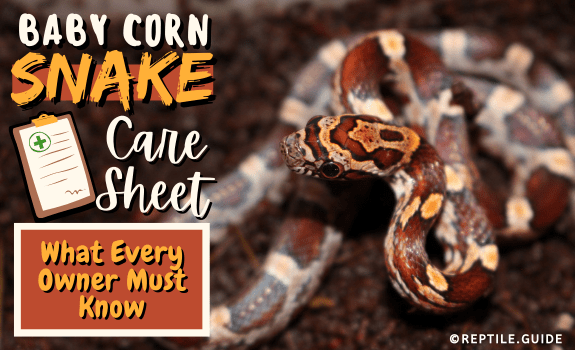Baby corn snakes, Elaphe guttata, are similar to adults in many ways, except that they’re much smaller, so they require less space and smaller meals.
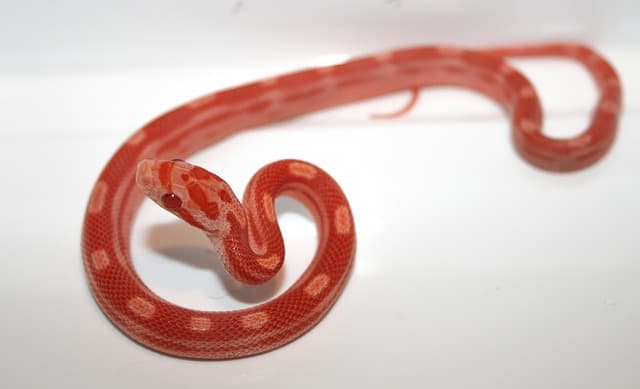
Let’s take a closer look at where to buy a healthy animal, and how to treat it once you get it home.
In This Article
Baby Corn Snakes in a Nutshell
- You can buy corn snakes at reptile expos or online marketplaces like MorphMarket.
- Feeding snakes doesn’t need to, and mostly shouldn’t, include live prey.
- A temperature gradient is essential in a baby corn snake’s enclosure.
- Start baby corn snakes on pinkie mice and increase the food size as the snake grows.
Where to Buy a Baby Corn Snake
In the past, it was quite difficult to find a reputable supplier of captive-bred corn snakes.
Today, things are MUCH simpler. Most breeders of corn snakes take great pride in their animals and breed many morphs.
Unfortunately, you can’t be sure that everyone who sells baby corn snakes has done due diligence in choosing snakes that are unrelated and have no genetic defects.
So how do you find a reputable dealer who can sell you baby corn snakes?
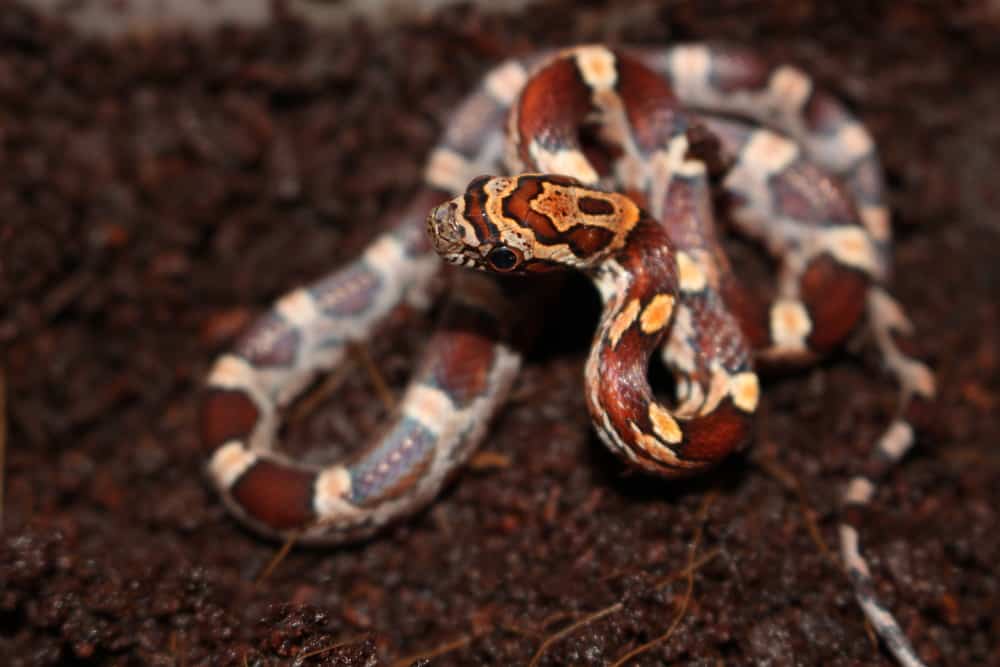
Many pet shops have agreements with breeders and stock full displays of baby corn snakes and other pet snakes.
Not all pet stores are reputable, and some may care more about turning a profit than quality animal care.
The other downside to the pet store approach is that you usually don’t get to talk to the breeder personally, so can’t gauge their expertise level.
One of the BEST options is to travel to your nearest reptile convention.
Expos and conventions feature hundreds of breeders who go through a thorough application process.
You can find anything from young corn snakes to adult corn snakes, and other pet snakes like ball pythons or milk snakes.
Unfortunately, not everyone lives within an accessible distance of a reptile convention or expo. If you’re one of them, you still have options.
One of the best ways to buy your new corn snake is through an online reptile marketplace.
MorphMarket is an exceptionally good website that stocks many different snake species, including corn snakes.
If you buy a corn snake on this platform, your snake will be shipped with express delivery and typically arrive at your location within 24-36 hours.
How Much Do Baby Corn Snakes Cost?
The price you pay for your new corn snake depends almost entirely on the morph that you choose.
Rare morphs cost significantly more, while wild-type morphs are a lot cheaper.
For instance, a basic amel would cost you around $65 at the time we wrote this article. An albino corn snake costs around $40.
An inferno motley would cost you around $300, which is average for semi-common morphs.
Rarer morphs like the palmetto can fetch anything from $600 to $750, depending on its genetic potential.
The short answer is, the corn snake is priced according to what the adult corn snakes of that morph look like.
Housing Baby Corn Snakes
Housing a young corn snake is easy, as long as you ensure that their enclosure has a tight-fitting lid.
Most corn snakes are escape artists and will happily escape through any gap they can fit their heads into.
It’s essential that the enclosure you choose has a tight-fitting lid, and mesh covers on any ventilation that the corn snake may escape through.
Temperature and Humidity
When you set up the temperature for your corn snake enclosure, it’s essential to create a warm end and a cool end.
This temperature gradient allows the snake to choose whether it wants to raise its body temperature or drop it.
For example, once it has been fed, the corn snake will move to the warm end where the heat can help it digest its meal.
You can heat the warm side by using a heating pad, heat mat, or heat tape. If you live in a truly cold area, you can also heat the cool side, but to a lesser extent.
Aim for the following temperatures:
Warm end: 88-92°F
Cool end: 75-82°F
Ambient temperature: 80°F
You can manage the temperatures with three high-quality thermometers.
One on the cool side, one on the warm side, and one in the middle of the enclosure to measure ambient temperatures.
A corn snake prefers a relative humidity of 40-50%.
Substrate
There are many different substrate options for your corn snake enclosure, but some are better than others.
The best option of all is Aspen shavings. This affordable, lightweight substrate allows the corn snake to burrow, as it would in the wild.
A baby corn snake will need around two to three inches of substrate, but a larger snake can benefit from deeper layers.
If you’re using deep layers of bedding for the corn snake, you might want to consider a basking lamp, so the snake can get warm on the surface.
Hides
Your baby corn snake will require multiple hides to meet its needs.
While a deep layer of bedding provides the snake with plenty of security, it may prefer to sleep in the enclosed confines of a hide.
Since a corn snake is exothermic, and absorbs heat rather than producing it, its hides should be positioned so it can moderate its body heat.
Most snake owners provide three hides:
- one on the hot side
- one on the cool side
- a humidity box for when the snake starts to shed
How to Handle a Baby Corn Snake
Handling a baby corn snake is easy, though it takes some caution.
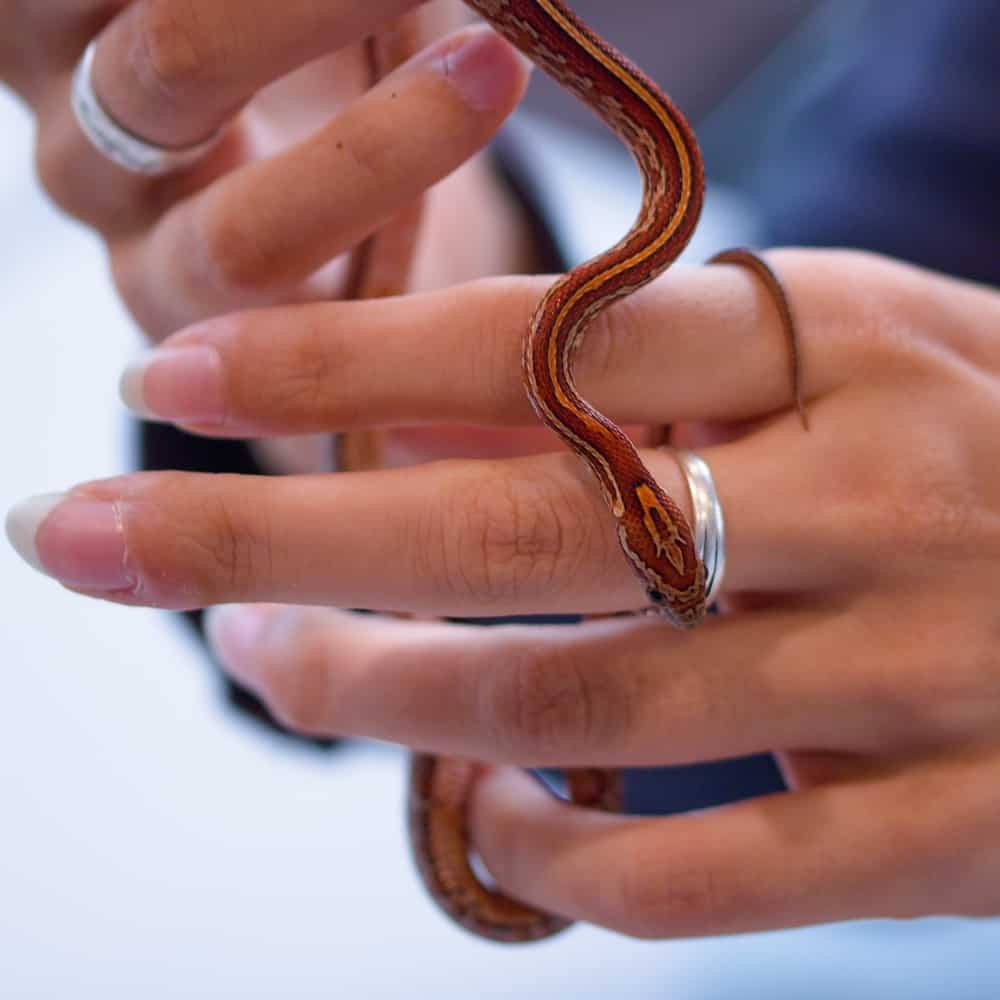
You can follow these steps when you handle your snake:
- Gently lift your snake from its enclosure.
Top Tip: If your snake shows signs of stress or even minor aggression skip the handling. It’s better to develop trust between you and your pet by allowing it to get used to you before you attempt to handle it.
- Cup your hands together, and allow the snake to slither around in your cupped hands.
- Your snake will probably slither around while using its sense of smell to explore its surroundings.
- Ensure that you always have your second hand in place to catch the snake if it moves off your first hand.
- Try not to handle your baby corn snake for more than ten minutes at a time. With age, it will calm down, and settle down for longer handling.
Never try to handle your snake if it’s about to shed, on a day that you fed it, or after handling mice and rats.
It may smell the rodent scent on your hands and think you’ve come to give it food.
How Often Should I Handle My Baby Corn Snake?
You want to handle your baby corn snake often so that it can get used to you.
At a minimum, handle your snake twice a week. Never handle your snake more than once a day though, as it may get stressed out.
What Should You Feed Baby Corn Snakes?
In the wild, a full-grown corn snake may eat birds, rats, mice, or any other live food it can catch. They also have a reputation for eating other snakes.
What do baby corn snakes eat?
In captivity, you should never feed your corn snake birds or live rodents. These pets will willingly eat most small prey items, which makes them easy to feed.
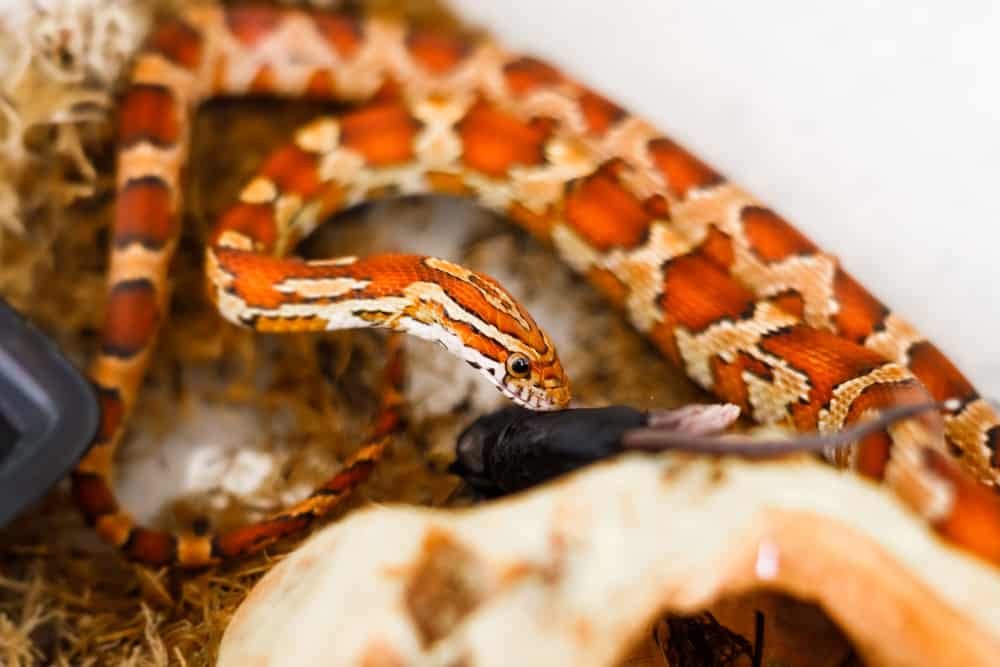
Bear in mind that an unvaried diet can create a health issue, so provide as much safe variety as possible.
Give your baby corn snake pinky mice and fuzzy rats to start with, increasing the size of the meals as they grow.
Remember that your new pets aren’t going to get very large, so you won’t ever be feeding them anything larger than an adult mouse.
Other potential food sources for baby corn snakes include small feeder lizards and frogs.
These snakes don’t eat a lot and you can expect to feed a single meal once every five to seven days. A pack of ten frozen pinky mice will last for quite a while.
Does a Baby Corn Snake Bite Hurt?
A baby corn snake bite isn’t a common occurrence, and even large snakes rarely bite their owners.
If your baby snake strikes at you, you’ll likely experience nothing more than the feeling of something tapping against your skin.
Hatchlings have almost no teeth worth mentioning, so it’s unlikely that they’ll manage to sink their teeth into you.
As the baby grows, so will its teeth, and a snake may latch onto you if it thinks you’re something it can eat.
If your snake latches onto you, NEVER PULL its head backward.
Not only can you break the snake’s teeth, but they’ll tear through your flesh making a gaping wound where you’d only have had puncture marks otherwise.
If you wait a short while, the snake should naturally release its jaws when it realizes it can’t eat you.
Assuming the snake doesn’t let go, you can also drip cold water on the place where the snake has latched.
Since the snake can’t afford to lose body heat, it will quickly release its hold on you.
Are Baby Corn Snakes Aggressive?
Young corn snakes and hatchlings aren’t aggressive at all.
As we mentioned earlier, these reptiles may strike playfully when they’re young, but they’re not being aggressive.
When faced with danger, most young corn snakes go into hiding or try to escape. They tend to be shy and nervous creatures, rather than aggressive.
Corn Snake Hatchling
Some new keepers find the term hatchling confusing and aren’t sure what the difference is between a hatchling and a baby.
Hatchling is merely the term for snakes that have recently emerged from their eggs and typically haven’t undergone their first shed.
You can keep a corn snake hatchling the same way as a baby of a different age. They may accept food within hours of hatching, though some only start eating after their first shed.
We hope that this article about keeping baby corn snakes has been valuable to you. As with any topic, there’s lots more to learn.
Most care sheets cover the basics, so expand your research by reading some of our other articles.
If you’re not sure whether a corn snake is right for you, check out our Corn Snake vs. Ball Python article to help you consider it in-depth.
You may also want to have a closer look at our detailed corn snake care sheet.
If you’re getting a baby snake, what are you going to name your new pet? Let us know in the comments below.
